In this guide, We will cover everything you need to know about Microlearning. We will discuss its importance, examples, courses from which you can learn this, and a lot more.
With quite busy schedules, traditional learning methods are not effective these days. That’s where microlearning comes into play – a better and unique approach for your effective learning.
No more delays, let’s begin!
What is microlearning?
Microlearning is an educational approach in which the learning content is divided into small parts that are easier to learn and understand. With the help of this approach, you can learn about any specific topic in a short period.
Microlearning definition in simple words, microlearning helps you learn about any particular topic in very little time without going into a detailed explanation. These micro lessons or modules can be of various formats including text, videos, photos, games, quizzes, etc.
Microlearning in Education
Microlearning is based on the Forgetting Curve which explains how you eventually forget information if you don’t try to review it regularly. For example; Today, you learn about a new topic and remember everything about it. Moving further, after 2 days, you might only remember half of it. Consequently, you might only remember the name of the topic after a month and nothing about the topic.
It become popular in education for its accessible and highly engaging content formats. Here are the microlearning examples of how it is useful in the field of education.
- Interactive Videos: A short 4 to 5-minute video to explain a single concept like arithmetic progression or how to solve a quadratic equation. In this, the video may include step step-by-step method brief explanation, and an example.
- Infographics and quizzes to quickly understand history in a fun engaging way.
- Educational apps like Duolingo, Quizlet, Coursera, and more. Incorporating these educational apps or software in the curriculum helps schools and colleges achieve more efficiency and better results.
- Games to teach concepts like coding is a great example of microlearning in education.
If schools, colleges, and organizations include these microlearning tactics in their curriculum, they can provide a more flexible and effective way of learning to their learners.
How to develop microlearning?
Developing microlearning completely depends on the learner’s requirements. Before developing, you should always think about the learner’s environment. For instance, Kids will love to learn through games whereas busy people might like infographics, flashcards, and podcasts.
Following is the stepwise explanation that is helpful for you in creating microlearning courses:
- Identify Course and Learning Objectives: You should clearly outline the course structure and should have an answer to what learners will understand by the end of their microlearning course.
However, You can use the SMART method for the same. The smart method stands for specific, measurable, achievable, relevant, and time-bound. According to that, your goals and objectives should be clear, and specific and you should know how much money, time, and effort it will take to succeed.
- Divide your content: You should always divide your content into small and easy-to-learn modules so that learners can complete it within 10 minutes.
- Choose the appropriate format: The format of your microlearning content should be according to your targeted users. Like, if your learners are kids then incorporating games, and quizzes can be really helpful.
- Don’t include detailed explanations: You should always focus on one specific concept.
- Prepare and plan strategies: It’s a general human behavior that we forget things very easily if not reminded timely. Therefore, you should plan techniques for regular reviews to ensure long-term retention.
- Instant feedback: You should provide instant feedback on the course completion, quizzes, and other activities of learners to motivate them.
- Multiple-device compatibility: Your microlearning content should be multi-device compatible. so that learners can access your course on their laptops, smartphones, or tabs.
- Using microlearning LMS also plays a major role: Choosing the correct learning management system will help you build an effective microlearning course and track the performances of various users. Using these LMS tools provides access to additional features like discussion forums, leaderboards, and others.
Principles of Microlearning
Microlearning focuses on delivering short yet very useful content. Whether for education, personal development, or employee training, these principles of microlearning make sure that your content is highly influential and result-driven. The following are the principles of microlearning with examples:
-
Focus on a specific topic
The first principle of microlearning explains that each microlearning module should explain a single concept at a time.
Example: Consider a 7-minute-long podcast explaining “How to download antivirus software” that should focus on steps for downloading instead of other explanations about what antivirus is or what they do.
-
Short sized content
The learning content should be clear, concise, and short which can be completed between 5 to 10 minutes. This will help you build retention of learners which results in high engagement rates.
Example: A 3-minute video that teaches you how to introduce yourself in a professional environment.
-
Highly engaging and Interactive
In microlearning, the content must be interactive and engaging for learners to keep them interested throughout.
Example: An interactive role-play activity in college based on interviews where students will get insights about the different scenarios and receive instant feedback from teachers according to their performances.
-
Real-time Learning
Microlearning enables users to learn anytime they want. In comparison, traditional learning is not self-paced, you have to complete all your courses within the specified duration whereas it is completely different in the case of microlearning.
Example: Platforms like Coursera, and Scalar offer a wide range of courses where you can learn with various formats like text, short videos, assessments, and exercises according to your schedule. Hence, if I am busy or don’t have time, it is no longer an issue.
-
Personalized and relevant learning path
The content should be practical and per the learner’s requirements.
Example: A short article on how to write an email with different examples is equally important for the personal and professional world.
-
Feedback and Assessment
Always make sure to include assessments after all the learning modules to access the knowledge and provide immediate feedback to learners to improve their efficiency.
Best Practices for Microlearning
The microlearning best practices are actions that are derived from the microlearning principles. Therefore, if you are following all the principles of microlearning, you will naturally be adopting best practices like defining clear & concise objectives, brief modules, interactive formats, and so on.
Now, let’s learn more about the best micro-learning apps to start your learning today.
Best Microlearning Platforms
After knowing what is microlearning and its importance, you must be looking for a good option to start your learning. However, there are so many Microlearning Software available.
In this section, you will get to know about the top 10 microlearning apps that stand out from the crowd.
1. LinkedIn Learning
Link: https://www.linkedin.com/learning/
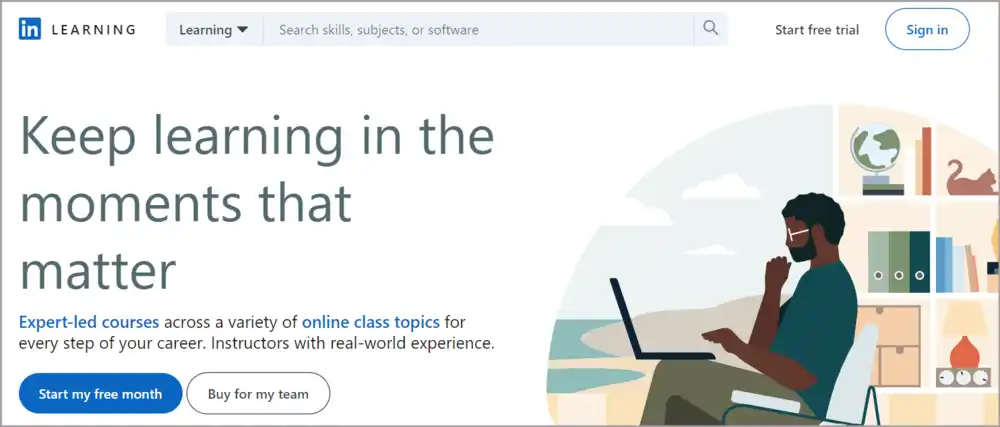
LinkedIn Learning is the first best microlearning platform acquired by LinkedIn. It was previously known as Lynda.com. If you are a new user, you can try it for a limited time. However, For unlimited access to all courses, it works on a subscription basis.
2. Coursera
Link: https://www.coursera.org/

Coursera is another best microlearning software that offers an extensive range of courses and is a partner with top universities like Standford, the University of London, and more. You can access many of the courses for free, but specialized courses, degree programs, and certificates are paid.
3. Kahoot!
Link: https://kahoot.com/

Kahoot is different from all other microlearning platforms. With the Kahoot game-based platform, you can learn in a fun and more engaging way. You can use this platform in education, organizations, and at home. With the free version, you can play simple quizzes whereas more game options require a paid subscription.
4. Duolingo
Link: https://www.duolingo.com/
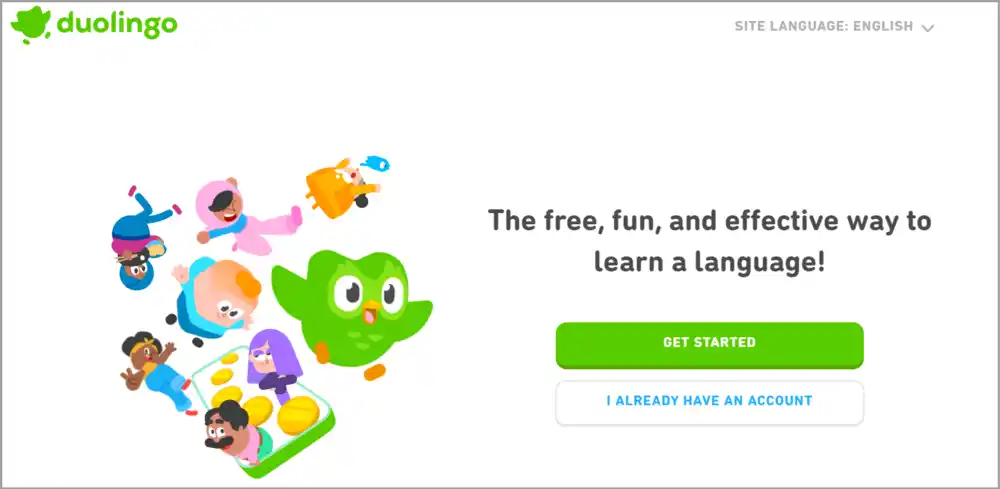
If the ad is not an issue and you are looking for a free micro-learning app, you can consider Duolingo. Duolingo is a platform to learn new languages in an entertaining way. There are additional features like interactive exercises, gaming lessons, setting daily goals, multi-language support, etc.
5. TinyTap
Link: https://www.tinytap.com/
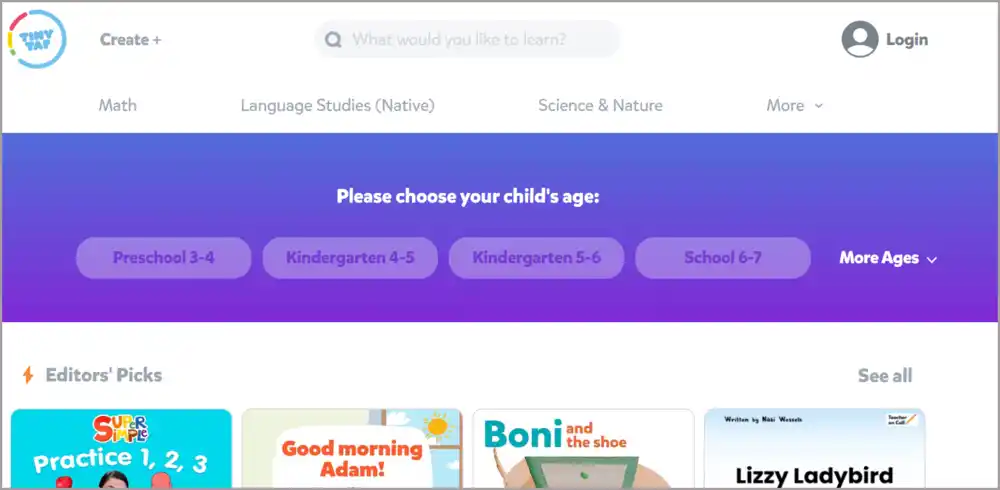
TinyTap is a learning app that allows users to create educational and interactive games with simple drag-and-drop functionality. Therefore, anyone can use this very easily without having technical skills. The content format on this micro-learning platform includes quizzes, puzzles, storybooks, learning games, poems, and so on.
6. Skillshare
Link: https://www.skillshare.com/en/

Skillshare is known for its creative focus on different categories including design, photography, writing, video making, animation, freelancing, and more. You can learn these skills with the help of real projects under the guidance of industry professionals. Additionally, it operates on the subscription model.
7. Bloomfire
Link: https://bloomfire.com/

Bloomfire is a centralized platform for organizations to share knowledge, resources, and other information. You can either use it for your business or your teams to collaborate with others. It is a paid tool but you can request a demo through their website.
8. Allego
Link: https://www.allego.com/
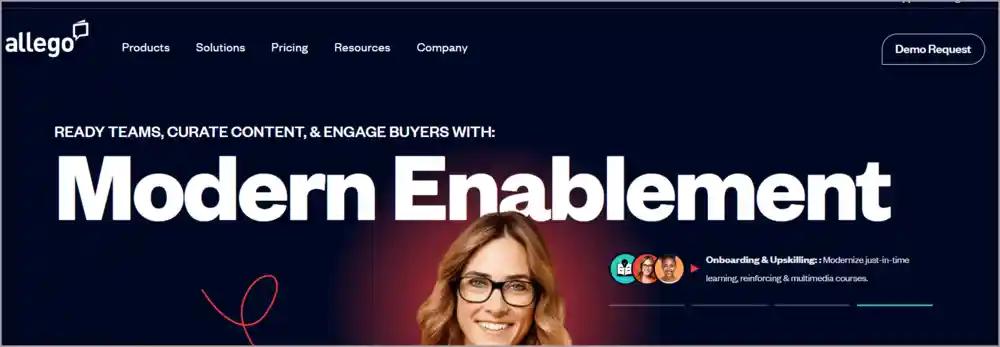
Allego is the best microlearning platform if you want to learn about sales or want to enhance your team’s performance by providing them with training. It offers interactive modules such as video-based learning, practical exercises, and personalized feedback for increasing the efficiency of sales teams.
9. EdApp
Link: https://training.safetyculture.com/

EdApp is now known as SC Training and follows a mobile-first approach. It is a learning platform for employee training and development. Furthermore, it provides a pre-built content library which makes it time-efficient.
10. Usetiful
Link: https://www.usetiful.com/
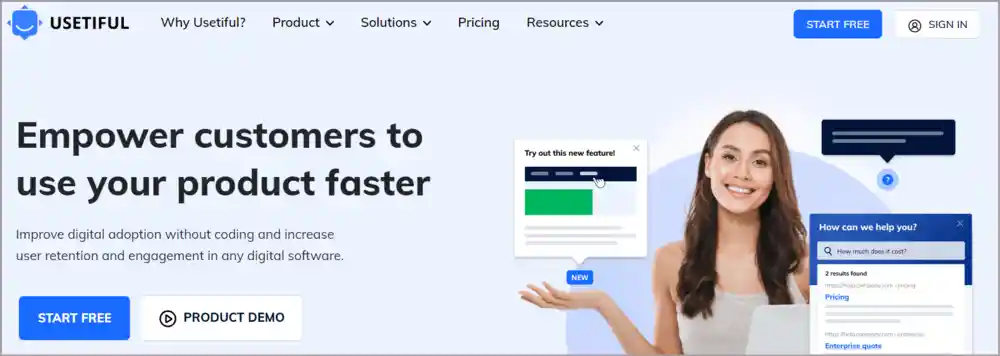
With the help of Usetiful, you can design product tours without knowing anything about coding. It helps you increase engagement by creating interactive tours and tutorials to completely understand and utilize new software.
Types of Microlearning
There are various types of microlearning including videos, infographics, quizzes, podcasts, etc. Let’s get to know about them in detail below.
Micro-Videos
Creating short videos of about 3 to 5 minutes is a great way to explain new concepts to learners quickly. For example: How to use new features of the application or How to install a tool.
Infographics
Infographics are a way to represent information and knowledge in a graphical way with the help of graphs, and minimal text. For example, An infographic consisting of steps to prepare for your job interview or tips to build your self-confidence.
Quizzes and Flashcards
Quizzes and flashcards are a fun way to access the knowledge base of learners and test their understanding. For instance, A compulsory short quiz after completing a module on any learning platform lets you review your learnings.
Podcasts and Audio Clips
Podcasts and audio clips are very helpful for someone who travels or works in a noisy environment. With audio content, they can learn anytime and on the go.
Micro-lessons
Micro lessons contain text-based lessons on specific topics that can be completed within 5 minutes. It should not contain a detailed explanation rather should stay to the point.
Knowledge Checks
Knowledge checks are helpful in gaining an idea about the learner’s understanding. Hence, providing them with the necessary feedback to identify knowledge gaps. For example, you can use polls, quizzes, and adaptive assessments for knowledge checks.
Educational Games
Using gamified elements in learning platforms increases user’s engagement and interest. You can use features like rewards, leaderboards, and unlocking new stages to build curiosity and motivate learners. Like, learners earn points every time they complete a module.
How-To Guides
Additionally, you can use How-to guide type microlearning which provides easy and clear instructions for performing a task. For instance, A step-by-step guide on how to set up a new account on a particular application.
Email-based Learning
Email-based learning includes sending the educational content directly into the mailbox with all necessary steps and overview. Such as sending new challenges to your students to practice new skills with tips and introductions.
Interactive PDFs
Interactive PDFs are another type of microlearning that contains interactive elements like fillable forms, clickable links, audio and video embedded, and tooltips.
Social Learning Posts
You can also use your social media to share quick tips, knowledge, and learning updates through social learning posts. Learners can interact with these posts through the comment section.
Augmented Reality Experiences
With the help of technology like augmented reality, you can experience the real world using virtual devices. Like, without wearing makeup in actuality, you can try how will it appear on you. Also, you can experience a 3d visualization of complex machinery, furniture, and more.
Scenario-based Learning
Scenario-based learning is an approach in which you learn from real-life situations. It helps you to develop skills namely problem-solving, decision- making and analytical. Here is an example of scenario-based learning for high school students:
Suppose you are working in a team of four, and you have to submit your project by tomorrow. But one of you has not even started his work. Now, your task is to submit it on time. There could be many possible solutions and you have to choose the best one. This is how scenario-based learning helps you learn new practical skills.
Simulations
Simulation-based learning is something similar to role-plays where you are supposed to act like it’s real. It’s more like practice before playing a match. You must have seen that all the organizations provide training to their new employee so that they can understand how they need to work.
For example, Customer service simulation helps you learn how to handle customers on a call in different scenarios.
Microlearning apps
Last but not least, Microlearning apps like LinkedIn Learning, Kahoot, Duolingo, etc. can be helpful for you to gain knowledge about specific topics with no structured schedule.
Microlearning vs Traditional Learning
Microlearning and traditional learning are two different learning approaches. However, they both have their advantages and disadvantages. Selecting which out of the two is better depends on certain factors including your target audience, goals, etc.
If your concern is in-depth knowledge then the traditional approach is best for you whereas microlearning is better for learners with a busy schedule.
Here is the comparison of microlearning and traditional learning for a better overview.
- In microlearning, it includes small size modules that usually complete in 3 to 5 minutes whereas traditional learning includes longer, detailed course modules.
- The content in microlearning platforms is in formats like quizzes, infographics, games, and videos. On the other hand, traditional learning consists of lengthy textbooks and lectures of up to 1 hour or more.
- The objective of the microlearning platform is to provide specific information about a particular topic while traditional learning provides in-depth knowledge about the topics.
- Traditional learning is less flexible compared to microlearning. You can learn anywhere, anytime with learning platforms whereas traditional learning requires you to follow a structured curriculum and schedule.
- Microlearning platforms are highly interactive and accessible compared to traditional methods.
- Microlearning platforms provide instant feedback to their learners through interactive elements whereas feedback in the traditional approach can be less immediate.
Why care about microlearning?
By the end of this section, you will have an answer to what is microlearning and why care about it. Microlearning is becoming popular in educational as well as professional development for various reasons like corporate training, and professional development. Here are the benefits of microlearning:
- Improved Retention: Microlearning platforms provide small, bite-sized modules that take less time to finish. Hence, learners don’t need to sit for hours resulting in overall improved retention.
- Enhanced engagement because of highly effective and enjoyable learning content.
- Microlearning gives all the best options to learners which is perfect for their busy schedules. They can learn anywhere, anytime they want.
- It is cheaper than traditional courses.
- Easy to update: Content on LMS is easier to update as it’s completely online.
- Highly scalable: Learning platforms that are not based on traditional approaches are highly scalable, you can easi;y accommodate growing demands, new features, and content on your LMS.
- Personalized learning paths: Learners can learn anything they want. They are not forced to learn the same course as others. But, they can identify the knowledge gap and pursue what is best suited for their personal growth.
- Instant feedback: It provides regular feedback to identify and keep track of their progress. And thus, adjusting their learning paths accordingly.
Conclusion
That concludes the encyclopedic guide to Microlearning. In this article, We have explored microlearning, its benefits, principles, and best practices. Additionally, we have listed numerous microlearning platforms to kickstart your learning journey. The micro-learning approach will help you learn new concepts in an effective and self-paced manner.
